You may think it is easy to cook hard boiled eggs.
I can only agree with you if you can tolerate the hard-boiled eggs that are hard to peel, with over-cooked egg whites, crumbly egg yolks that lined with a greenish ring.
Unfortunately, many restaurants, street vendors, and specialty eateries serve such low-quality eggs. I am not sure why, but perhaps they just do not bother or not taking seriously to put some effort to make it right. You can cook the much better hard boiled eggs at home by just following the simple steps below. (Yes! Sometimes I feel disappointed that the ‘restaurant standards’ is no longer the gold standard for the amateur homemakers).
Do the eateries take hard boiled eggs seriously?
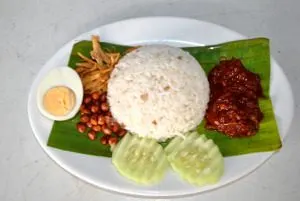
Hard boiled eggs are part of the accompaniment for nasi lemak (coconut milk rice), and nasi campur (mixed rice) in Malaysia. Many cafes and restaurants serve eggs that are overcooked, with an unsightly greenish ring around the egg yolks.
I made a search on the internet to look out if someone has posted a good recipe for making hard boiled eggs. There are many recipes published on the internet, but none of this method truly produce the result that I wanted for the perfect hard boiled eggs.
So I ran a series of experiments last week. If I am able to find the answer, I am happy to share it with everyone. (I have just heard from my colleagues that a customer of mine who happens to be a chef said he will never share his recipe with anyone except to his family member. In this blog, I am just doing the opposite!).
How is the perfect hard boiled eggs should be?
My goal is to look for for the perfect hard boiled eggs recipe that is able to fulfill the following criteria:
- Easy to peel eggs that looks smooth, not looking like the surface of the moon.
- Tender egg white, not rubbery.
- Creamy, not crumbly egg yolks.
- Free from any ugly greenish layer on the surface of the egg yolk even after a day.
Validate how to make hard boiled eggs with a series of tests
It took longer than I expected to perfect the method of preparation of hard boiled eggs. I started to test the temperature and cooking time by referring to some well-known food blogs and articles.
The first set of results turned out to be undercooked. I cooked the eggs in boiling water for 1 minute with the aim to set the exterior of the whites and drop the temperature to 80°C/176°F for 13 minutes. The average weight of my eggs is 58g.
At first, I suspect the thermometer is faulty. However, I confirm it is accurate with the second thermometer. So I hypothesized that the heat from the water might not raise the internal temperature of the egg whites to 80°C/176°F at the end of 13 minutes, which leaves the inner part of the egg white and the yolks undercooked.
The result was amazing!
For my second attempt, I started to boil the eggs in boiling water for one minute, and maintain the temperature at 85°C/185°F for 16, 18 and 20 minutes respectively.
Tested recipe based on the science of boiling eggs
OK. If you just want to make the perfect hard boiled eggs, you can stop reading and jump straight to the recipe below.
However, if you want to know the reason why this method works, please read on.
Let me reiterate the perfect hard boiled eggs should be:
- Easy to peel eggs that looks smooth, not looking like the surface of the moon.
- Tender egg white, not rubbery.
- Creamy, not crumbly egg yolks.
- Free from any ugly greenish layer on the surface of the egg yolk even after a day.
Let me break it down into sections.
1. How to make the shell easy to peel
If you start by cooking the eggs in boiling water until they are fully cooked, the eggs shells are definitely easy to peel. Why? Because by then the egg white is already hardened and you have not worried to damage the surface of the eggs. However, you get rubbery egg whites, which is not desirable.
However, it is a challenge to make the just-cooked hard boiled eggs, but yet easy to peel. You will notice there are a few steps in the process t make it happen.
Start with boiling the eggs for one minute.
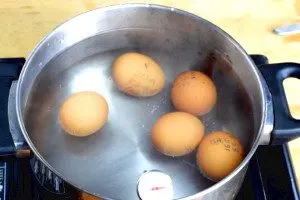
When you plunge the eggs into boiling water, the temperature of the water is above the temperature to set the egg whites. Therefore, the exterior of the egg whites will begin to set even before returning to the lower temperature for the next fourteen minutes. The set exterior of the egg whites will make the peel much easier.
If you start to cook the eggs at a lower temperature, the egg whites will tend to bond strongly to the egg membrane, making it hard to peel.
Cool the egg rapidly in an ice bath
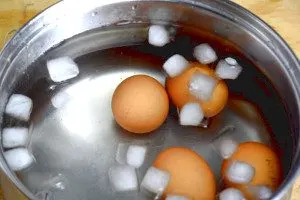
This is the method used by the Japanese chef making onzen tamago and ramen eggs.
Once the eggs are cooked, plunge them into an ice bath immediately. Let it chill for at least 15 minutes or overnight if you are not using them immediately. This ice bath cools the eggs, make the egg whites firmer, and less likely damage when you pry off the shells.
Crack the egg surface to allow water seeps under the shells
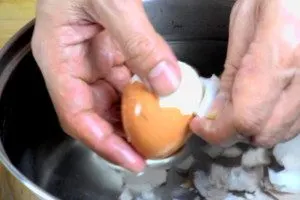
Crack the eggshell all over and soak in water make peeling of the shell easier.
If you still find it difficult to peel the shells, try to use a blunt object like the back of a metal spoon to tap around the eggs to crack the shells all over. After that, return the eggs to the water bath and soak for 15 minutes.
The cracks created allow the water to seep in under the shells. The shell will practically fall off from the eggs.
2. Why is a green layer form on the surface of the overcooked egg yolk?
You need to understand the basic chemistry of the eggs to understand why this happens. In short, this is caused by a chemical reaction between the egg yolks and the egg whites.
When you boil the eggs, the temperature rises and speeds up a chemical reaction.
Hydrogen sulfide is produced by the decomposition of sulfur-containing amino acid in the egg whites when it reaches 70°C/158°F. It will react with the iron in the egg yolk. The result is the formation of ferrous sulfide, which has a greenish to gray color on the surface of the egg yolk. The color is unsightly although harmless when consumed.
Fortunately, this chemical reaction only happens when the temperature reaches 70°C/158°F. Therefore, the tinging egg yolks can be avoided as long as the interface of the yolks and whites is below this temperature.
Since we maintain constant water temperature, the heat will raise the temperature starting from the exterior of the egg whites to the egg yolks at the center. The goal is to raise the temperature of the egg yolks to 70°C/158°F, which is the yolks will set. Putting the eggs into an ice bath is to bring down the temperature of the eggs once the yolks are set and preventing the further chemical reaction that caused the formation of ferrous sulphide, the unsightly green layer on the yolk.
That is why it is so important to boil the egg under control temperature and cool it in an ice bath to bring down the temperature as quickly as possible.
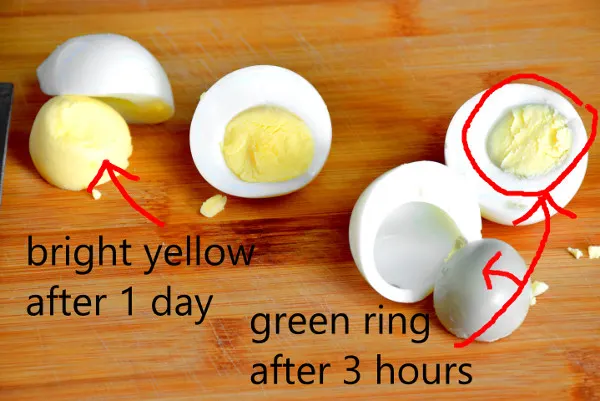
The egg on the left was cooked between 85°C/185°F and 90°C/194°F, and still bright yellow after 1 day. The egg on the right was cooked at 100°C throughout. It turned greenish on the surface after 3 hours.
3. What is the temperature of the egg whites and yolks to set?
What is the best temperature for boiling eggs? Many food stores in Malaysia are serving hard boiled egg as part of the condiments for nasi lemak. Unfortunately, many of these eggs are overcooked, taste rubbery and have an unsightly greenish layer at where the egg white and yolk meet. This dilemma can be corrected by boiling the eggs at the sub-boiling point of water.
Ovalbumin, the major component of egg white which consists of 54% of the egg white start to set at 80°C/180°F. Whereas the second larger component of ovotransferrin begins to set at 60°C/140°F. Egg yolk sets at around 70°C/158°F, and become crumbly when it reaches 90°C/194°F
Therefore, the best temperature of letting the egg to set but not being overcooked is at the temperature just above 80°C/180°F and below 90°C/194°F.
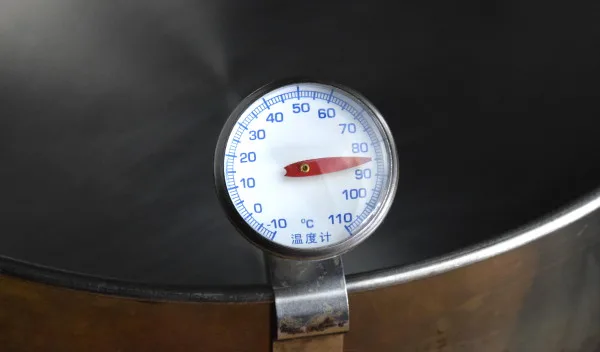
7 Factors affecting the quality of hard boiled eggs
It is easy to boil eggs, but to make the perfect hard boiled egg is a delicate task and involves many variables. The recipe in this article is based on medium size eggs (average 58g), boil with plain water at sea level.
Read on if you are still unable to cook a perfect hard boiled egg. Try to understand the common variable that might affect the result and make the adjusting of the temperature and timing accordingly.
Try to understand the common variable that might affect the result and make the necessary adjustments of the temperature and timing accordingly.
The main factors
1. Egg temperature– The initial egg temperature can affect the eggs. My recipe is based on eggs that are at room temperature at about 25°C/77°F. You need to remove the eggs from the refrigerator for at least twenty minutes before cooking the eggs. If you cooking the eggs in a temperate country, you need to extend the duration of boiling.
2. The size of the eggs– I use medium size egg weighed 58g on average. The bigger the eggs, the longer the cooking time.
3. Vinegar and baking soda– Some articles mentioned that both vinegar and baking soda could help to make the eggs easier to peel. I boiled the eggs with water only as the effect of both substances is insignificant.
4. Lid on versus lid off– Before I carried out the test, I used to boil the eggs at 100°C/212°F for 5 minutes, then remove from heat with the lid on for another 9 minutes. The effect is not as good as this one as it tends to overcook the eggs. The only reason I put the lid on is to retain the beat of the water after removing them from the stove.
In this recipe, I leave the lid off since I need to monitor the temperature throughout the process by submerging a thermometer in the water.
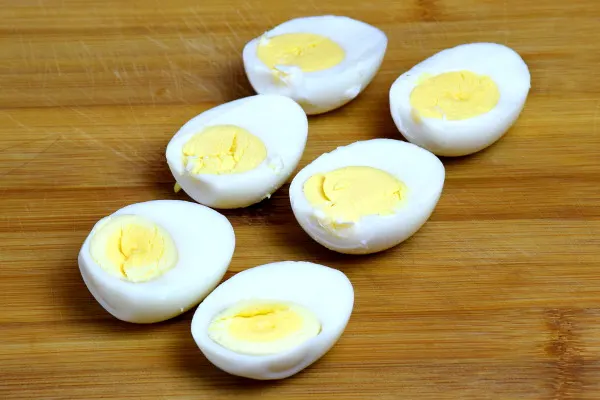
Other factors
5. The amount of water– It is not important to fix the amount of water to boil the egg. However, the level of water should be at least one inch above the eggs for even cooking.
The amount of water only becomes important if you use other methods which required to remove the water from heat. In this case, the less water you use, the faster the eggs will cool down, which will affect the result significantly.
6. Altitude – The boiling temperature of the water drops as the altitude rises. I boil my egg in Kuala Lumpur, which is close to sea level. If you are living high on the mountain, you need to increase the cooking time.
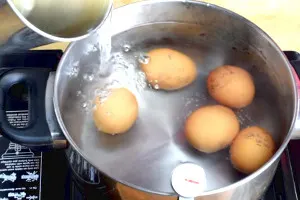
Add cold water to the boiling water to keep it at 85°C.
7. Room temperature – If you are boiling the eggs during winter, you may want to prolong the cooking time for a few minutes. Since the initial temperature of the eggs is lower, the heat needs a longer time to reach the internal to set the egg yolks, I have tested the result of eggs that cooked for an additional two, four and six minutes respectively at the constant temperature of 85°C/185°F. The difference in the result is marginal.
The perfect hard boiled eggs recipe
So here is my tested recipe for making hard boiled eggs, with firm but not rubbery egg whites, creamy egg yolks, easy to peel and not visible greenish ring formed on the surface of the egg yolk.
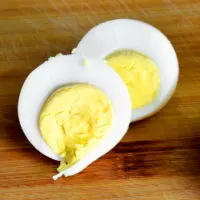
The perfect hard boiled eggs
This recipe is tested for cooking the perfect hard boiled eggs.
Ingredients
- Six pieces of eggs, average 58g each
You also need:
- A pot of water
- Some cold water
- Ice bath
- Kitchen thermometer
Instructions
- Bring out the eggs from the refrigerator and let them return to room temperature before use.
- Bring the water to a boil. Plunge the eggs into boiling water for one minute. The water level should be at least one inch above the eggs.
- Reduce the temperature of the water to between 85°C/185°F and 90°C/194°F by adding some cold water to the pot. Simmer the eggs at this temperature for 14 minutes.
- Transfer the eggs to an ice bath immediately. Soak them for 15 minutes until the eggs are completely cold.
- Remove the eggs. Refrigerate the eggs in the shells until you want to use them. It can be refrigerated up to a week.
- To serve, gently cracking the eggs all around without peeling them. Return the eggs to warm water and soak it for 10 minutes. The egg shells will be able to peel off easily.
Recommended Products
As an Amazon Associate and member of other affiliate programs, I earn from qualifying purchases.
Nutrition Information:
Yield: 6 Serving Size: 1Amount Per Serving: Calories: 14Total Fat: 1gSaturated Fat: 0gTrans Fat: 0gUnsaturated Fat: 1gCholesterol: 36mgSodium: 17mgCarbohydrates: 0gFiber: 0gSugar: 0gProtein: 1g
This data was provided and calculated by Nutritionix on 5/25/2019
Reference
1. How to Avoid a Green Ring Around Hard-Boiled Egg Yolks
2. Sous Vide Eggs
3. The Science of Boiling an Egg
4. Towards the perfect soft boiled egg

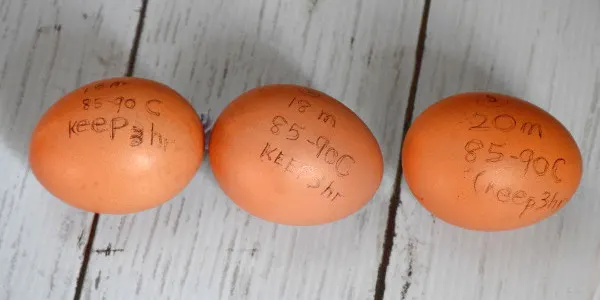
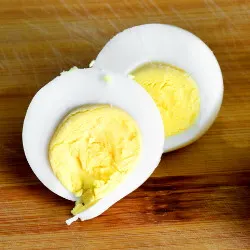
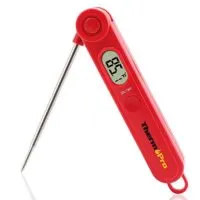
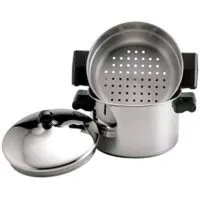
2025-11-20 : Soy Sauce Chicken Recipe – Authentic Chinese-Style (豉油鸡) Made Simple | 大脚印
Friday 21st of November 2025
[…] check out this article for a detailed guide on making perfect hard-boiled […]
Soy Sauce Chicken Recipe – Authentic Chinese-Style (豉油鸡)
Sunday 16th of November 2025
[…] check out this article for a detailed guide on making perfect hard-boiled […]
Mee Rebus recipe- Malay noodles with sweet potato gravy
Friday 7th of November 2025
[…] Mee Rebus. I wrote an article explaining how to make the perfect hard-boiled egg. Please refer to that article for […]
Easy Nasi Lemak Recipe - Traditional Malaysian Breakfast Favorite
Wednesday 29th of October 2025
[…] classic accompaniment for nasi lemak is the humble hard-boiled egg. We have a complete guide on how to make perfect hard-boiled eggs on this blog, but here’s a quick […]
Taiwanese beef noodle soup recipe- How to cook to get the best flavor
Sunday 17th of August 2025
[…] either version, you can add hard-boiled eggs for extra protein and garnish with blanched vegetables such as bok choy for a fresh, colorful […]